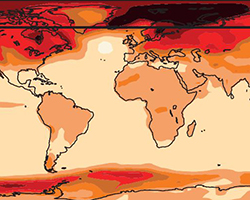26 Jan 2016
2°C global warming target will mean much higher temperatures in many regions

Professor Rob Wilby (Geography) has contributed to a major research paper (published this month in Nature) which warns of the wider climate impacts of a 2°C global warming target.
At November’s COP21 climate conference in Paris, world leaders agreed plans to limit global warming to "well below" 2°C.
But a study by climate experts at ETH Zurich (Switzerland), University of New South Wales (Australia) and Loughborough University shows a 2°C increase in global temperature could result in regional increases of as much as 6°C.
The impact has been illustrated by new graphical depictions of regional ‘hot spots’ in a 2°C world.
For Mediterranean countries, a global average temperature increase of 2°C could produce local temperature increases of around 3.4°C. To limit warming in this region to 2°C, the global temperature must rise by no more than 1.4°C (bearing in mind that in 2015 global warming set a new record of 1°C).
The most extreme changes may be seen in the Arctic where global warming of 2°C could see night temperatures in the far north increase by 6°C. Regions around the Arctic may have passed a 2°C temperature rise as far back as 2000 and, if emissions of greenhouse gases are not cut dramatically, areas around the Mediterranean, central Brazil and the contiguous United States could see 4°C of warming by mid-century.
The paper also highlights the impact of global temperature rises on heavy rainfall, with the majority of land areas predicted to increase.














